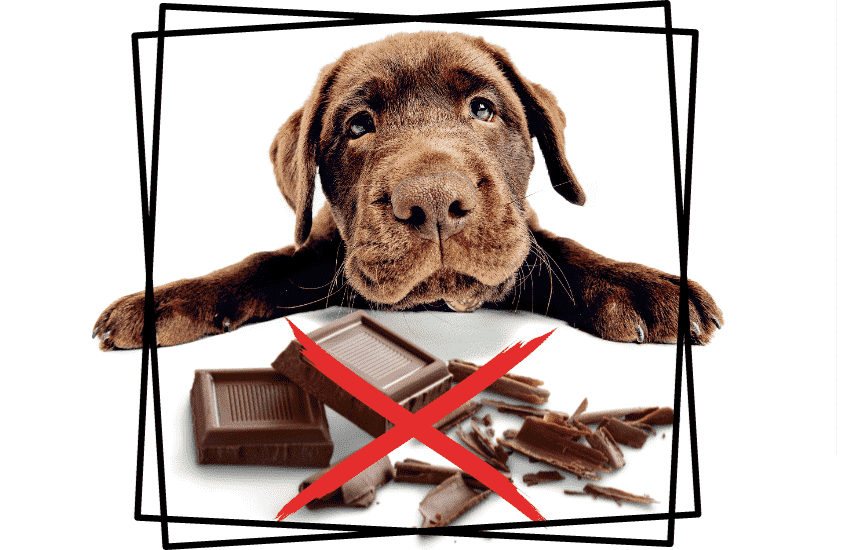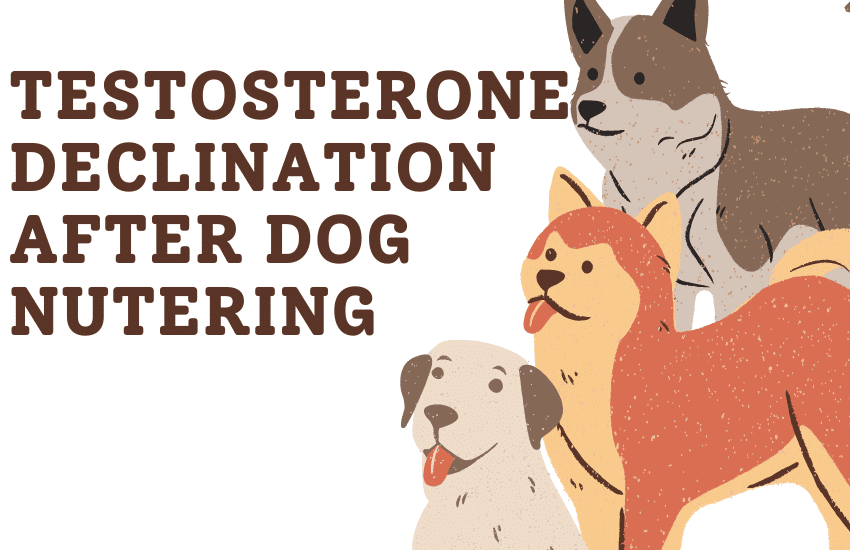As a dog owner, a situation you may dread is finding that your furry friend has gotten into a stash of forbidden treats – namely, chocolate. A common question that frequently pops up is, “What happens if a dog eats chocolate?” It is an understandable concern, given that most people know chocolate is bad for dogs, but few know exactly why, or what to do in such circumstances.
In this article, we delve into what happens physiologically if your dog eats chocolate, the dangers that lurk in each bite, and crucially, “what to do if your dog eats chocolate”. With vital insights from veterinarians and animal health experts, we aim to turn panic into caution should you ever face this potentially hazardous scenario. Whether you’re a new dog owner or just keen on keeping your pet safe, this article serves as a comprehensive guide on a crucial aspect of dog health and safety.
Why Is Chocolate Bad for Dogs?
What happens if a dog eats Chocolate? Chocolate is harmful to dogs primarily because of two naturally occurring stimulants: theobromine and caffeine. Both of these substances cause toxicity in dogs. They can lead to a range of health complications, even death if not promptly addressed.
Some dogs may be more sensitive to theobromine and caffeine than others, making even small amounts of Chocolate potentially harmful.
Theobromine: Theobromine, structurally similar to caffeine, is the main culprit in chocolate toxicity. It stimulates the central nervous system and the cardiovascular system. Dogs metabolize theobromine much slower than humans, so the effects are prolonged, leading to complications.
The half-life of theobromine, the time it takes for the body to eliminate half of the substance, can range from 6 to 17 hours in dogs. This prolonged half-life allows theobromine to stay in the dog’s system for an extended period, leading to more severe symptoms.
Caffeine: Although theobromine is the more dangerous chemical, Chocolate’s caffeine can also lead to poisoning. Like theobromine, caffeine stimulates the central nervous system and heart.
It’s crucial to note that the severity of chocolate poisoning depends on factors like the type and amount of Chocolate ingested, the dog’s weight, and individual sensitivity.
Even small amounts of Chocolate can be dangerous to dogs, so it’s always best to avoid giving Chocolate to them altogether. Suppose you suspect your dog has consumed Chocolate or shows any poisoning symptoms. In that case, you must contact your veterinarian immediately for guidance and necessary treatment.
Will Chocolate hurt dogs?
Let’s show some statistics first to answer this question and know how dangerous it can be.
- 20mg of theobromine per kilogram of body weight can cause mild symptoms
- 40mg of theobromine per kilogram of body weight can cause cardiac symptoms
- 60mg of theobromine per kilogram of body weight can make seizer symptoms
Let’s say you have a 20-pound dog.
Since 1 kg equals 2.2 pounds, this dog weighs about 9kg.
So 9kg x 20mg equals 180mg of theobromine, which could cause toxicity symptoms like vomiting, rapid breathing, increased heart rate, and restlessness.
A Hershey’s Milk Chocolate bar (1.55 ounces) has approximately 44mg of theobromine.
So if a 20lb dog ate around four squares (1.16 ounces) of a milk chocolate candy bar, that’s about 65mg of theobromine, which exceeds the highest toxic theobromine dose, which can lead to deadly symptoms.
Dark Chocolate is even more toxic due to much higher concentrations of theobromine. The bottom line is that no amount of Chocolate should be fed to dogs due to the risk of poisoning.
You can calculate How much Chocolate is toxic with this Chocolate for Dogs calculator
List of foods that are highest in theobromine:
Some of the most dangerous and toxic brands of Chocolate for dogs include:
Baker’s Chocolate: Baker’s Chocolate contains about 456 mg of theobromine per ounce, making it poisonous for dogs. Even small amounts can cause toxicity.
Dark Chocolate: The darker and purer the Chocolate, the more toxic it becomes. Many dark chocolates contain 200-500 mg of theobromine per ounce. Brands like Lindt and Ghirardelli test on the higher end.
Cocoa powder: There can be as much as 700 mg of theobromine per ounce of unsweetened cocoa powder, which is highly toxic to dogs. Popular brands include Hershey’s and Nestle.
Gourmet Chocolate: Many specialty chocolates, truffles, fudge, etc., have high cocoa content. Brands like Vosges, MarieBelle, and Robert Lambert make expensive gourmet chocolates that dogs should avoid.
Chocolate chips: Semi-sweet chocolate chips There can be as much as 160 mg of theobromine per ounce. Brands like Nestle, Hershey, and Guittard can cause toxicity.
The more bitter the Chocolate, the more dangerous it is for dogs.
Toxic doses depend on the dog’s weight, but it’s best to avoid feeding them any amount, no matter the brand. If consumed, dark and baking chocolate warrants immediate vet attention. Milk chocolate poisoning can still occur but may exhibit milder symptoms over time.
what happens if a dog eats chocolate-Symptoms of Chocolate Poisoning in Dogs
Chocolate poisoning in dogs is a severe condition caused by the consumption of Chocolate, which contains both caffeine and theobromine, substances that are toxic to dogs. Here are the symptoms to look out for:
- Hyperactivity: Due to the stimulating effects of caffeine and theobromine, the first sign of chocolate poisoning in dogs is typically hyperactivity or restlessness.
- Vomiting and Diarrhea: These can occur a few hours after ingestion and may include noticeable pieces of Chocolate.
- Increased Heart Rate or Irregular Heartbeat: These symptoms can result in panting, shaking, or seizures.
- Increased Urination: Increased urination may occur due to the theobromine’s diuretic effect.
- Muscle Twitches or Tremors: In severe cases, dogs may exhibit trembling or total-blown seizures.
- Excessive Thirst: This is another common symptom of chocolate poisoning.
- Elevated Body Temperature: One of the effects of theobromine and caffeine is an increased body temperature, which can further exacerbate other symptoms.

How long does it take for chocolate poisoning symptoms to start showing?
Symptoms of chocolate poisoning in dogs can usually be seen within 6 to 12 hours after ingestion. However, the severity and type of symptoms can vary significantly based on the amount and type of chocolate consumed, the dog’s size, and general health. In some cases, symptoms can manifest in as little as 1 hour.
In other cases, they may not be apparent until several hours after ingestion. Suppose you suspect your dog has ingested Chocolate. In that case, contacting a vet immediately rather than waiting for symptoms to appear is essential.
When to Call the Vet
If you notice these symptoms or suspect your dog has ingested Chocolate, contact your vet immediately. The degree of chocolate toxicity varies depending on the type and amount of Chocolate consumed and your dog’s size and health status.
Remember that it’s always better to be safe than sorry. Even if your dog seems fine after consuming Chocolate, it’s best to consult a vet immediately.
Even small amounts can be dangerous to dogs, and prompt veterinary care can make all the difference in the outcome.
What will the vet do with a dog who has eaten Chocolate?
If a dog has eaten Chocolate, the vet may take several steps to treat the situation depending on the amount and type of Chocolate eaten, the weight of the dog, and the time that has elapsed since ingestion:
- Inducing Vomiting: If the dog was recently exposed to the Chocolate (generally within 2 hours), the vet may induce vomiting to eliminate the Chocolate from the dog’s system.
- Administering Activated Charcoal: This can help bind any theobromine left in the dog’s stomach and intestines, preventing it from being further absorbed into the body.
- Intravenous Fluids: To keep the dog hydrated and help flush the theobromine out of their system faster, a vet may administer intravenous fluids.
- Monitoring Heart Rate and Blood Pressure: Theobromine can affect a dog’s heart rate and blood pressure, so that continuous monitoring will be carried out. If necessary, medication may be given to manage these symptoms.
- Medications for Seizures or Tremors: These are severe symptoms of chocolate poisoning and may require additional medications.
- Hospitalization: In severe cases, the dog may need to be hospitalized for close monitoring and treatment.
My dog ate Chocolate, but it seems fine.
Just like humans, dogs can have variations in their genetic makeup that affect how efficiently they process and eliminate certain substances. In the case of theobromine, different dog breeds or individuals within a breed may have variations in the enzymes responsible for metabolizing theobromine.
The enzyme responsible for metabolizing theobromine in dogs and humans is called cytochrome P450 1A2 (CYP1A2). Dogs with a more efficient and active form of this enzyme may be able to break down theobromine more quickly and effectively, reducing their risk of experiencing severe toxicity symptoms.
On the other hand, dogs with less efficient or inactive forms of this enzyme may have difficulty metabolizing theobromine, leading to its accumulation and increased toxicity.
It’s worth noting that while genetics might play a role in dogs’ ability to metabolize theobromine, it is not the sole determining factor. Other factors, such as the amount and type of Chocolate consumed, the size and health of the dog, and individual sensitivity, are also crucial in assessing the risk of chocolate poisoning in dogs.
Although small amounts of Chocolate may not immediately make your dog sick, they should refrain from consuming it. Research has shown that regular exposure to theobromine can contribute to the onset of cardiomyopathy in dogs, a chronic condition that affects the heart’s ability to pump blood effectively.
Even if your dog appears unaffected after consuming Chocolate, you should contact a veterinarian for guidance. They can assess the situation and determine whether any further action is necessary. Remember that prevention is critical – always keep chocolates and other potentially harmful foods out of reach from your pets.
What to Do if Your Dog Eats Chocolate
If your dog has eaten Chocolate, here are the steps you should take:
- Determine the type of Chocolate and the quantity ingested: The toxicity level of different types of chocolates is different. Dark Chocolate and baking chocolate are more toxic than milk chocolate.
- Note down your dog’s weight: This is helpful to determine the level of poisoning, as smaller dogs are more at risk.
- Keep a watch on the symptoms: Symptoms of chocolate poisoning in dogs include restlessness, increased urination, tremors, elevated or abnormal heart rate, seizures, and collapse.
- Contact your vet immediately: It’s essential to consult with a qualified professional who can advise you based on the case’s specifics. If possible, provide them with all the information you’ve gathered.
- Monitor your dog closely: Even if the amount of Chocolate eaten was small, monitor your dog closely for any changes in behavior or physical condition.
Remember, prevention is the best solution – always keep chocolates and other harmful foods out of your pet’s reach.
What kind of chocolate can dogs eat?
There’s no safe type of Chocolate for dogs to eat. All kinds of Chocolate, including white Chocolate, milk chocolate, semi-sweet Chocolate, Dark Chocolate, and baking Chocolate, contain theobromine to different extents.
This is a substance that’s harmful to dogs because they cannot metabolize it as efficiently as humans can. Even in small amounts, Chocolate can cause serious health problems in dogs, or in severe cases, it can be fatal.
It’s best to keep all Chocolate and chocolate-based products out of your dog’s reach to avoid potential risks.
How to Induce Vomiting in Dogs Who Ate Chocolate
Inducing vomiting in your dog should only be done under the guidance of a veterinarian because, in some cases, inducing vomiting can cause more harm than good, depending on what your dog has consumed.
If your veterinarian recommends inducing vomiting, one standard method is by using 3% hydrogen peroxide. Here’s how:
- Measure out 1 ml of 3% hydrogen peroxide per pound of your dog’s weight, with a maximum limit of 45 ml, even if the dog weighs over 45 pounds.
- Give your dog the hydrogen peroxide orally using a syringe or turkey baster.
- Wait 15 minutes. If your dog hasn’t vomited, give it another dose.
- Once the dog has vomited, do not give any more doses.
- Even if your dog vomits, get them to a vet as quickly as possible.
Remember, even when successful, inducing vomiting doesn’t expel all the toxins from the dog’s system. It’s essential to follow up with immediate veterinary care.
What is a good chocolate substitute for dogs?
Carob is one of the most popular and safe alternatives to Chocolate for dogs. Carob is a sweet and healthy substitute that is dog-friendly. Like Chocolate, it comes from a tree and can be ground into powder, chips, etc.
Despite its sweet taste, Carob does not contain theobromine or caffeine, which are the harmful components of Chocolate for dogs. It also contains beneficial nutrients like vitamins and calcium. You can find many dog treats and baked goods made with Carob in pet stores or online.
Another alternative is a dog-specific “chocolate” treats. These are typically made using a mix of flour, Carob, and other dog-safe ingredients and are formed and colored to look like Chocolate. However, these treats should still be given in moderation. Always check the ingredients in any pet food or treat to ensure they are safe for your pet.
Remember: even though these are safe alternatives, they should still be a small, occasional part of your dog’s diet. Regular dog food should make up most of their diet for proper nutrition.
What about mulch made from cocoa bean shells?
Cocoa bean shell mulch, also known as cocoa mulch, is a popular garden product due to its pleasant aroma and rich brown color. However, it potentially poses a hazard to dogs. The mulch is a by-product of chocolate production. It contains theobromine – the same ingredient in Chocolate that is toxic to dogs.
If consumed, cocoa mulch can cause symptoms similar to chocolate poisoning in dogs. These symptoms can range from an upset stomach to more severe complications like muscle tremors, seizures, or even death in extreme cases.
As an alternative, consider using other types of mulch, like shredded cedar or pine, which are safe for pets. Supervise your pets while they are around mulch to prevent them from eating it.
How to Prevent Your Dog from Eating Chocolate
- Keep Chocolate out of reach: Always store it where your dog can’t reach it. This can be high shelves, closed cabinets, or containers your dog can’t open.
- Educate the family: Make sure everyone in your family, especially kids, understands the danger of Chocolate for dogs. Explain the importance of not leaving Chocolate where the dog can access it and not feeding it as a treat.
- Secure your trash: Dogs often go through the trash to find food and might find chocolate or chocolate wrappers. Use a dog-proof trash can, or store it where your dog can’t get to it.
- Be careful with holiday treats: Safely store holiday chocolate like Easter eggs or Halloween candy. Make sure they aren’t left within reach of dogs during festivities.
- Train your dog: Teach your dog basic obedience commands like “Leave it” or “Drop it.” These can be particularly helpful when you see your dog attempting to eat something harmful.
- Use a pet gate: Use pet gates to keep dogs out of rooms where food is frequently found, like the kitchen or dining room.
It’s abundantly clear that chocolate and dogs don’t mix. The effects of chocolate, even in small amounts, are potentially hazardous to your dog’s health and wellbeing, leading to complications such as stomach upset, irregular heart rhythms, or even worse, seizures.
But don’t panic – if you find yourself asking, “what to do if your dog eats chocolate?” remember that fast action and the right information can be the lifesaving difference. Rush your dog to the veterinarian at the earliest sign of cocoa consumption and ensure you keep dangerous sweets out of paw’s reach. Armed with the right knowledge and a vigilant eye, we can ensure a safer environment for our dogs where the only treats they indulge in are both delicious and dog-friendly.







